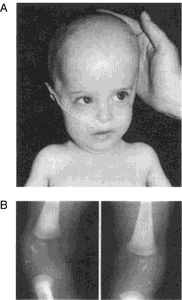DEFINITION
Zellweger syndrome also called cerebrohepatorenal syndrome,is a rare, congenital disorder present at birth,characterized by the reduction or absence of peroxisome in the cells of the liver,kidneys,and brain.
Zellweger syndrome is one of a group of four related diseases called peroxisome biogenesis disorders PBD.
The diseases are caused by defects in any one of 13 genes, termed PEX genes, required for the normal formation and function of peroxisomes.
The PBDs are divided into two groups: Zellweger spectrum disorders and Rhizomelic Chondrodysplasia Punctua spectrum.
The Zellweger spectrum is comprised of three disorders that have considerable overlap of features.
These include Zellweger syndrome (ZS, the most severe form), Neonatal adrenoleukodystrophy , and Infantile Refsum disease (IRD, the least severe form).
Zellweger syndrome is the most severe form of the Zellweger spectrum.
Individuals with Zellweger syndrome develop signs and symptoms of the condition during the newborn period.
Zellweger syndrome is also known by the following names:
* Generalized Peroxisomal Disorders
* Peroxisomal Biogenesis Disorders
* Zellweger Syndrome Spectrum
* ZSS

CAUSES
Zellweger syndrome is an autosomal recessive disorder caused by mutations in genes that encode peroxins, proteins required for the normal assembly of peroxisomes.
Most commonly, patients have mutations in the PEX1, PEX2, PEX3, PEX5, PEX6, PEX10, PEX12, PEX13, PEX14, PEX16, PEX19, and PEX26 genes.
In almost all cases, patients have mutations that inactivate or greatly reduce the activity of both the maternal and paternal copies of one these aforementioned PEX genes.
As a result of impaired peroxisome function, an individual's tissues and cells can accumulate very long chain fatty acids (VLCFA) and branched chain fatty acids (BCFA) that are normally degraded in peroxisomes.
The accumulation of these lipids can impair the normal function of multiple organ systems, as discussed below. In addition, these individuals can show deficient levels of plasmalogens, ether-phospholipids that are especially important for brain and lung function.
Zellweger syndrome leads to elevated levels of copper and iron in the cell tissue and blood to cause a variety of serious symptoms, including facial deformities, retardation, and seizures.

EPIDEMIOLOGY
● Frequency: 1: 50.000- 100.000
● Sex relation: M:F= 1:1
● Age: Birth or after birth
The birth prevalence of PBD-ZSS is estimated to be around 1/50,000 in North America,and around 1/500,000 in Japan.
The highest incidence of Zellweger Syndrome was reported in the Saguenay-Lac St Jean region of Quebec (around 1/12,000).
SYMPTOMS
Zellweger syndrome symptoms usually include:
**Profound hypotonia (low muscle tone)
**Feeding problems
**Profound mental retardation
** Seizures
**Hearing and vision loss
**Distinctive facial features (flattened face, broad nasal bridge, high forehead)
** Liver and kidney disease
** Chondrodyplasia punctata (x-ray findings of scattered calcification at the end of the long bones and knee)

DIAGNOSIS
�* Biochemical testing
The diagnosis of Zellweger syndrome can be definitively determined by biochemical assays.
Biochemical abnormalities detected in blood and/or urine should be confirmed in cultured fibroblasts.
Measurement of plasma very-long-chain fatty acid (VLCFA) levels is the most commonly used and most informative initial screen. Elevation of C26:0 and C26:1 and the ratios C24/C22 and C26/C22 is consistent with a defect in peroxisomal fatty acid metabolism. Mutations in twelve different PEX genes (PEX1, PXMP3 [PEX2], PEX3, PEX5, PEX6, PEX10, PEX12, PEX13, PEX14, PEX16, PEX19, and PEX26) — those that encode peroxins, the proteins required for normal peroxisome assembly — have been identified in PBD, ZSS.
* Clinical testing
PEX1 mutation is the most common cause of Zellweger syndrome, associated with about 68% of all affected individuals
* Prenatal diagnosis and preimplantation genetic diagnosis (PGD) for at-risk pregnancies require prior identification of the disease-causing mutations in the family. Prenatal diagnosis by biochemical testing is also possible; ideally, the biochemical defects in cultured fibroblasts from an affected family member should be confirmed first.
PATHOGENESIS
Pathogenesis of peroxisomal deficiency disorders (Zellweger syndrome) may be mediated by misregulation of the GABAergic system via the diazepam binding inhibitor.

PATIENT RISK FACTORS
Since Zellweger syndrome is an inherited, genetic disorder, heredity is the only known risk factor. An affected child must inherit a copy of the Zellweger gene from both parents.
With only one gene from one individual parent present in their body, the child is merely a carrier, and will not present any symptoms of the condition.
One in 50,000 infants are affected by the disorder. Sex and ethnicity do not affect.
COMPLICATIONS
** Zellweger syndrome children are susceptible to life-threatening respiratory problems.
** Gastrointestinal bleeding
** Liver failure
** Brain damage
THERAPY
Treatment of Zellweger syndrome is primarily symptomatic and supportive.
Infections should be guarded against carefully to delay complications, and Vitamin K may be needed to avoid abnormal bleeding.
Experimental therapies with docosahexaenoic acid (DHA) are being studied.
DHA is an essential fatty acid, which is deficient in patients with Zellweger syndrome has been reported in some patients.
Another approach being tested is the administration of bile acids, such as cholic acid or chenodeoxycholic acid, which may be of help in respect to liver function.
PROGNOSIS
The prognosis for Zellweger syndrome is very poor.
Most infants do not survive past six months of age. Causes of death are usually respiratory distress, gastrointestinal bleeding, or liver failure.
CONCLUSION
The National Institute of Neurological Disorders and Stroke (NINDS), and other institutes of the National Institutes of Health (NIH), conduct research exploring the molecular and genetic basis of Zellweger syndrome and the other PBDs in laboratories at the NIH, and also support additional research through grants to major medical institutions across the country.
Much of this research focuses on finding better ways to prevent, treat, and ultimately cure disorders such as Zellweger syndrome .
.